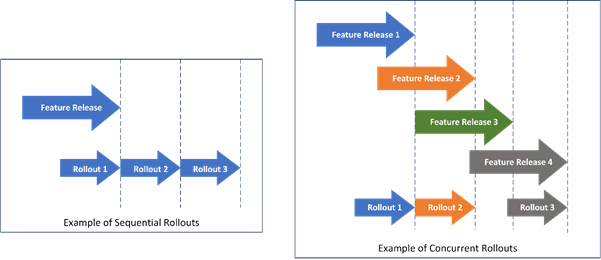Global Rollouts
What have we learned from rolling out SAP Sales & Service Cloud (C4C) globally?
Implementing an integrated solution becomes challenging when rolling it out to multiple countries with process and data variations. This blog summarizes the lessons learned from global SAP Sales & Service Cloud rollouts for customers with thousands of users across 50+ countries. These lessons are also applicable to other SAP or SaaS solutions.
What is a global template rollout, and why should I care?
A global template solution can be rolled out sequentially or concurrently. Concurrent models are attractive because they provide early incremental business benefits and opportunities for iteration. Rollouts bring all features available at the time, and SAP’s quarterly releases should be factored into the strategy to maximize benefits. The following image shows examples of sequential vs. concurrent rollouts.

What are the typical challenges?
Typical challenges include unmet business needs, poor data quality, system instability, misaligned business processes, inadequate communication, organizing user testing and training, lack of user adoption, limited perceived benefits, and changing business requirements.
Here’s a simplified guide to the top 10 tips for a successful global rollout:
Agree on the specification and strategy: Establish an early agreement on the initial solution and determine your release and rollout strategy. Deliver a Minimum Viable Product (MVP) for quick benefits and plan for iterative enhancements. It is crucial to actively manage and prioritize the product backlog for this to work.
Ensure team engagement: Engage key users from the business and maintain consistent involvement. Identify a central decision-making team for the template solution and designate local champions for regional execution. Consider the workload of these individuals and adjust plans accordingly to minimize project risk.
Adapt business processes: Remain open to changing existing processes, focusing on creating a standardized global template. Evaluate regional variations and assess whether they are necessary (legal/regulatory). Prioritize standard best practice scenarios for long-term business benefits.
Set up communication and governance model: Implement a strong governance model and maintain clear communication channels to drive user adoption and prepare for change. Clearly define roles, responsibilities, and escalation paths to address project issues effectively.
Think about data: Poor quality data will make even the best technical solution look meaningless. Prioritize data migration for project success. Assess and plan for regional data migration, involving data experts early in the project. Develop a data migration strategy that aligns with the overall rollout plan.
Measure benefits from the beginning: Identify key KPIs and define requirements for proper benefit tracking. Incorporate analytics from the start of the project and establish a system for measuring progress toward goals. Develop a clear understanding of expected benefits.
Test and feedback: Involve key users in continuous feedback and conduct regression testing for new releases. Foster open communication between business users and project team and consider automation of regression testing to streamline processes.
Train, and then Train again! Provide both initial and delta training for new capabilities, including SAP product upgrades. Develop a structured training plan using short, modular courses and consider online delivery for flexibility. Update training materials with new features and capabilities.
Have the right tenant strategy for your landscape: Ensure your tenant landscape supports the release and rollout strategy with the proper number of tenants in sync. Assess the impact of enhancing the solution for current users while training new users on previous releases. Collaborate with technical teams to maintain a consistent and efficient tenant landscape.
Learn and improve: Conduct open “Lessons Learned” sessions for continuous improvement. Promote honest feedback without blame, applying the Chatham House Rule for effective participation. Use these sessions to identify and implement improvements in subsequent releases or rollouts.
Learning from experience is valuable, and these learnings can provide guidance for those embarking on similar journeys. By considering these tips and learning from experience, you can ensure a successful global rollout and achieve maximum business benefits. Feel free to discuss this further or share your experience with us.
Latest Blogs
As CISOs or cybersecurity decision-makers, how often do you come across questions such as "Am…
Last week, I had the privilege of attending Informatica World 2025 in Las Vegas, a landmark…
Introduction Vehicle Insurance has long been known for its complexity. Why? Because it relies…
Core banking platforms like Temenos Transact, FIS® Systematics, Fiserv DNA, Thought Machine,…




